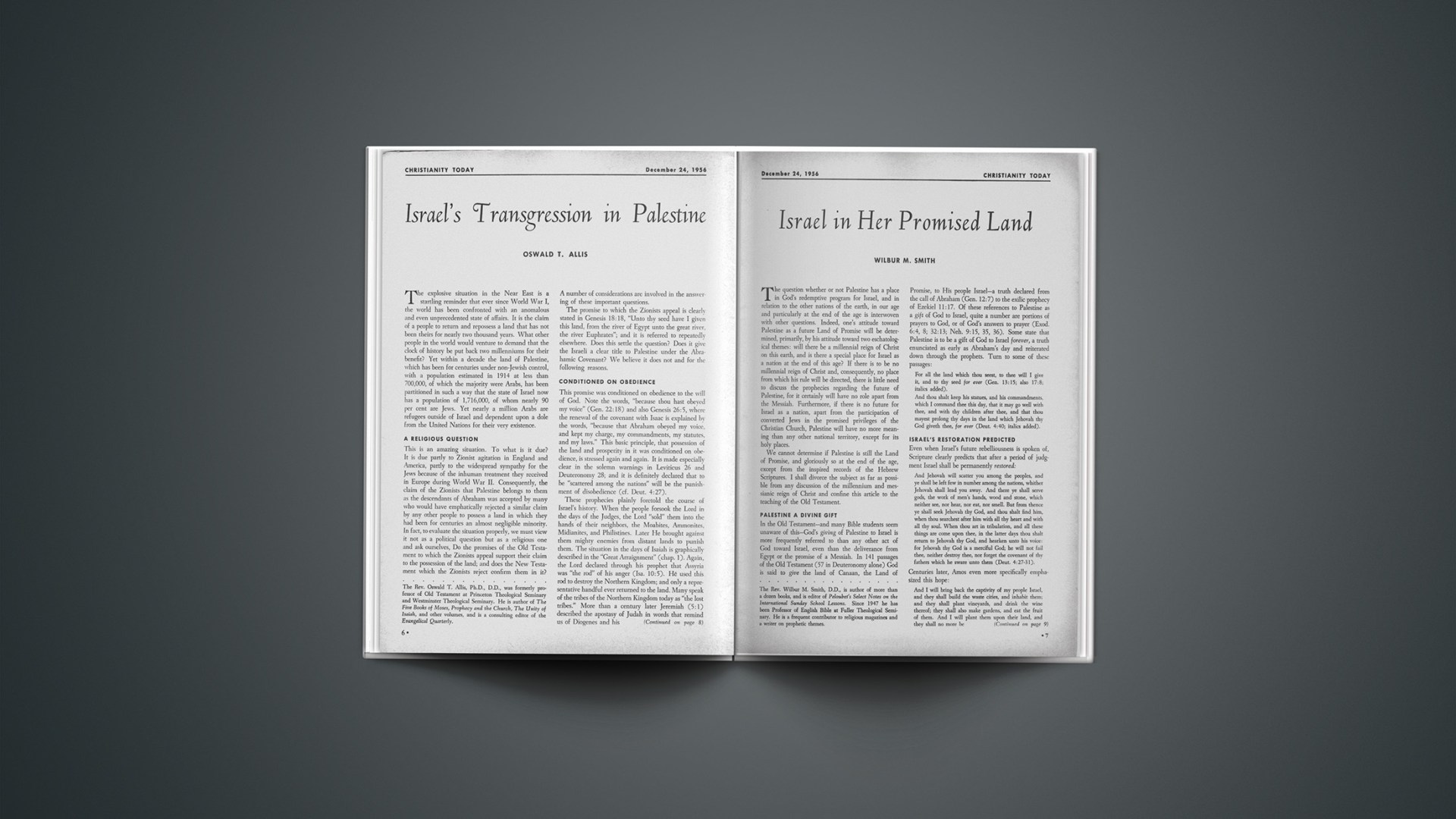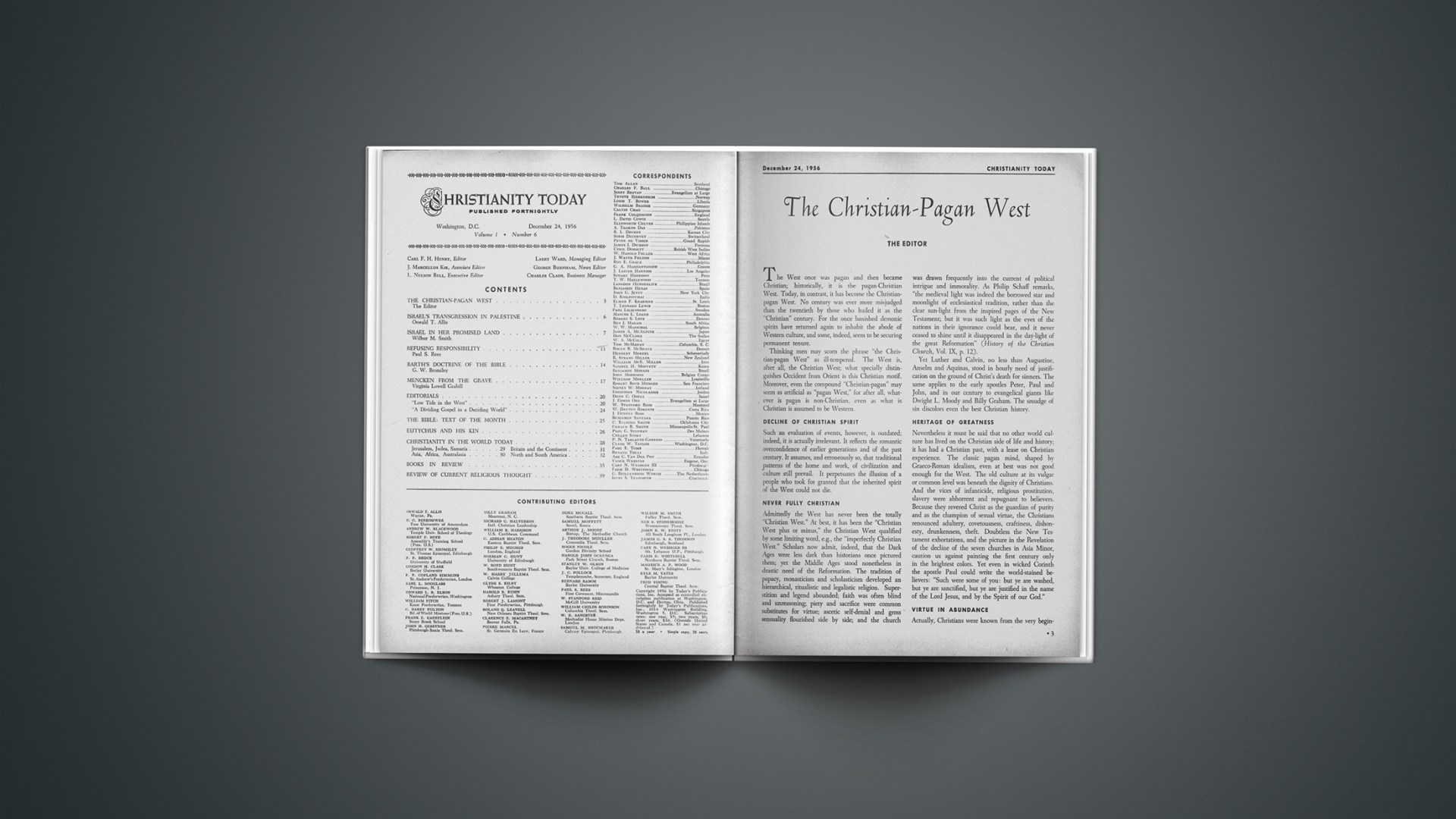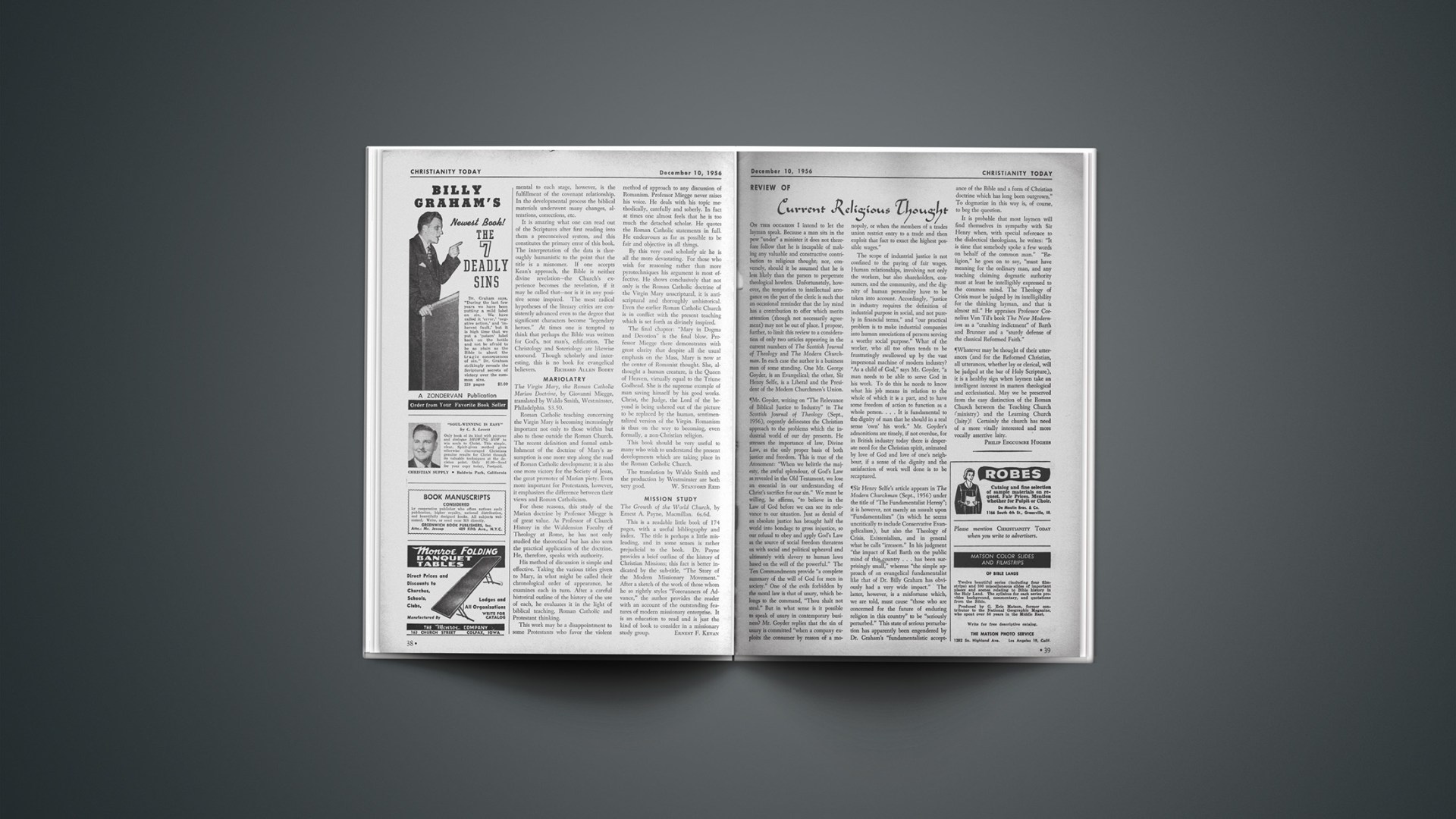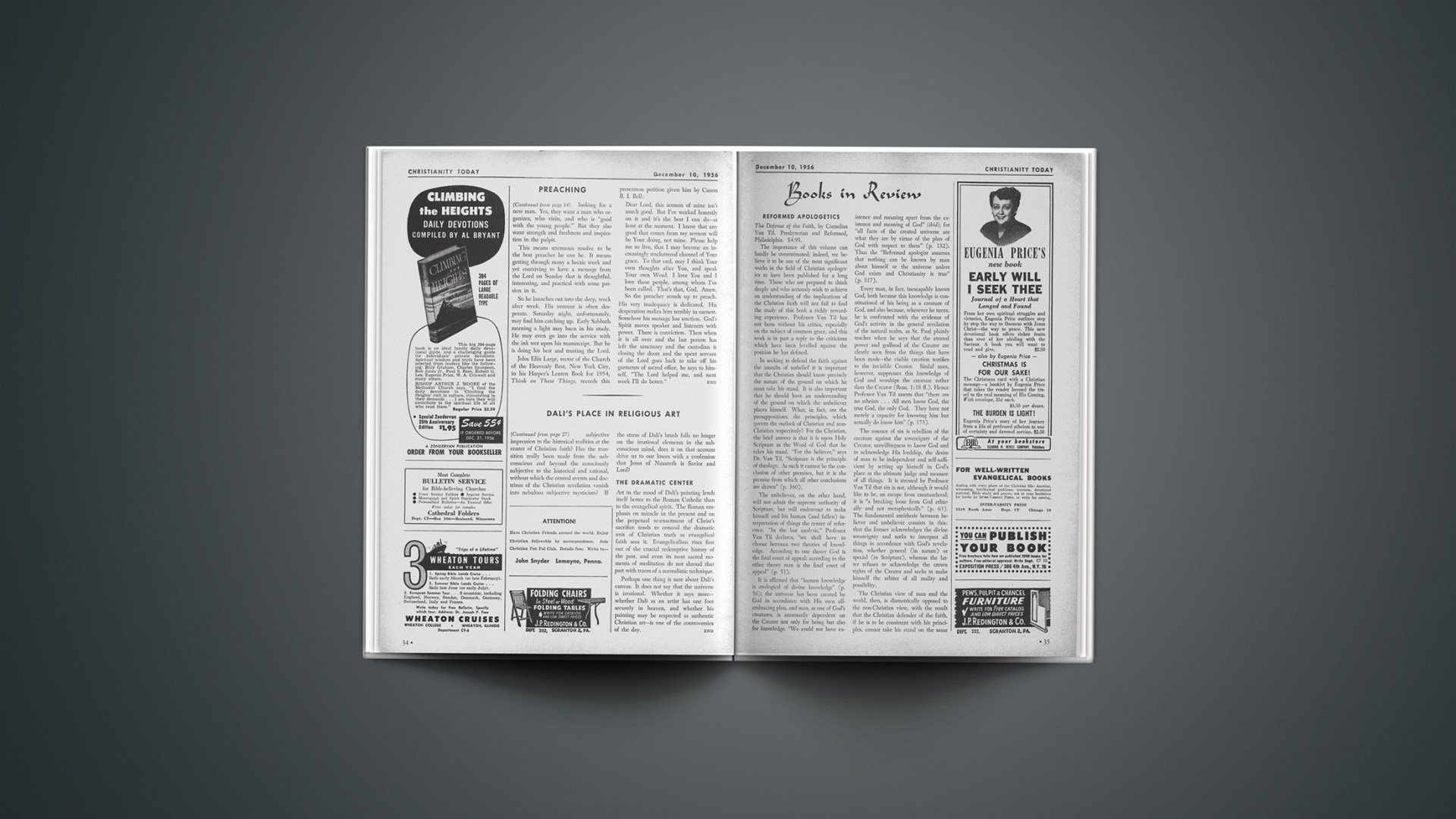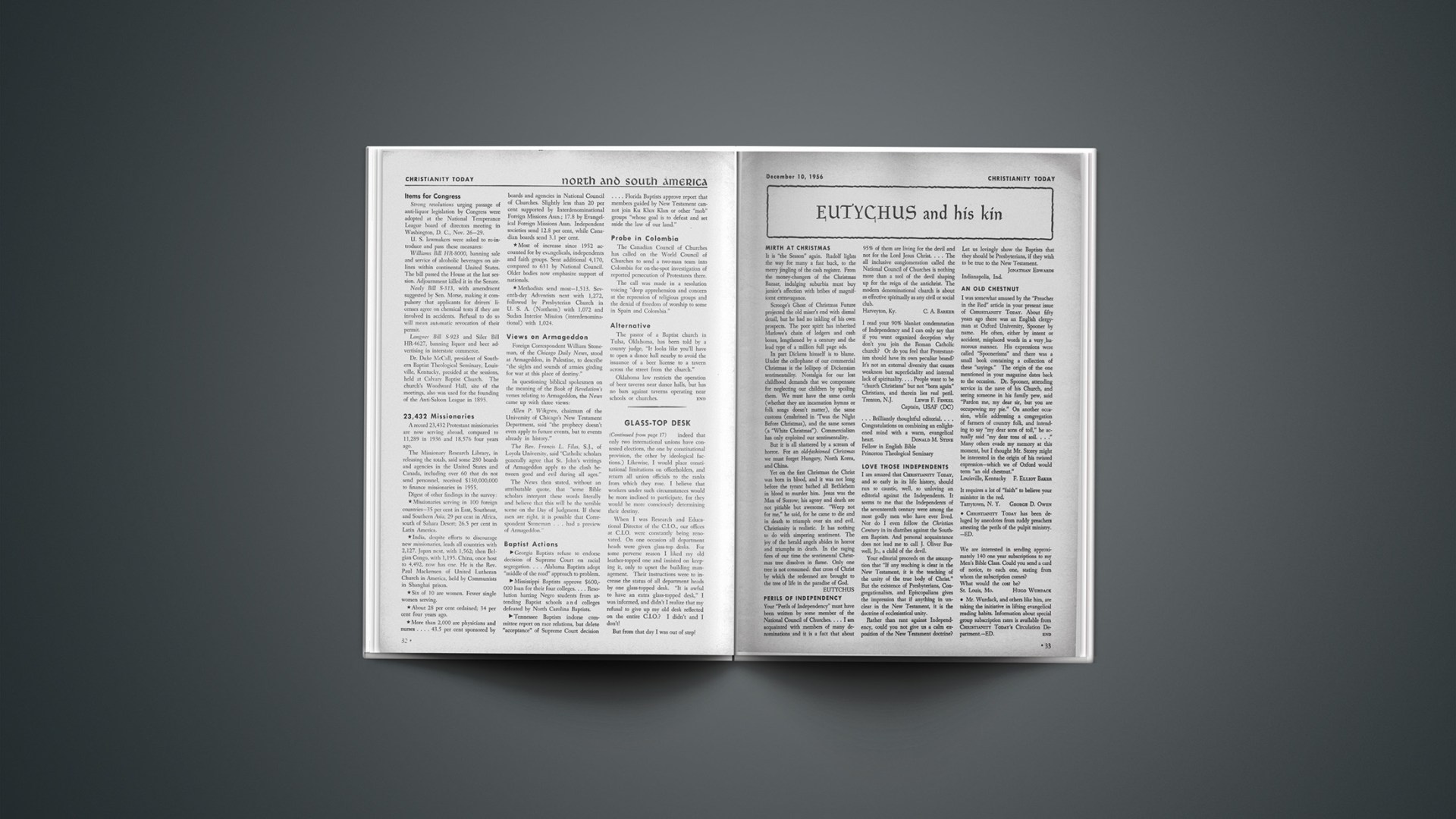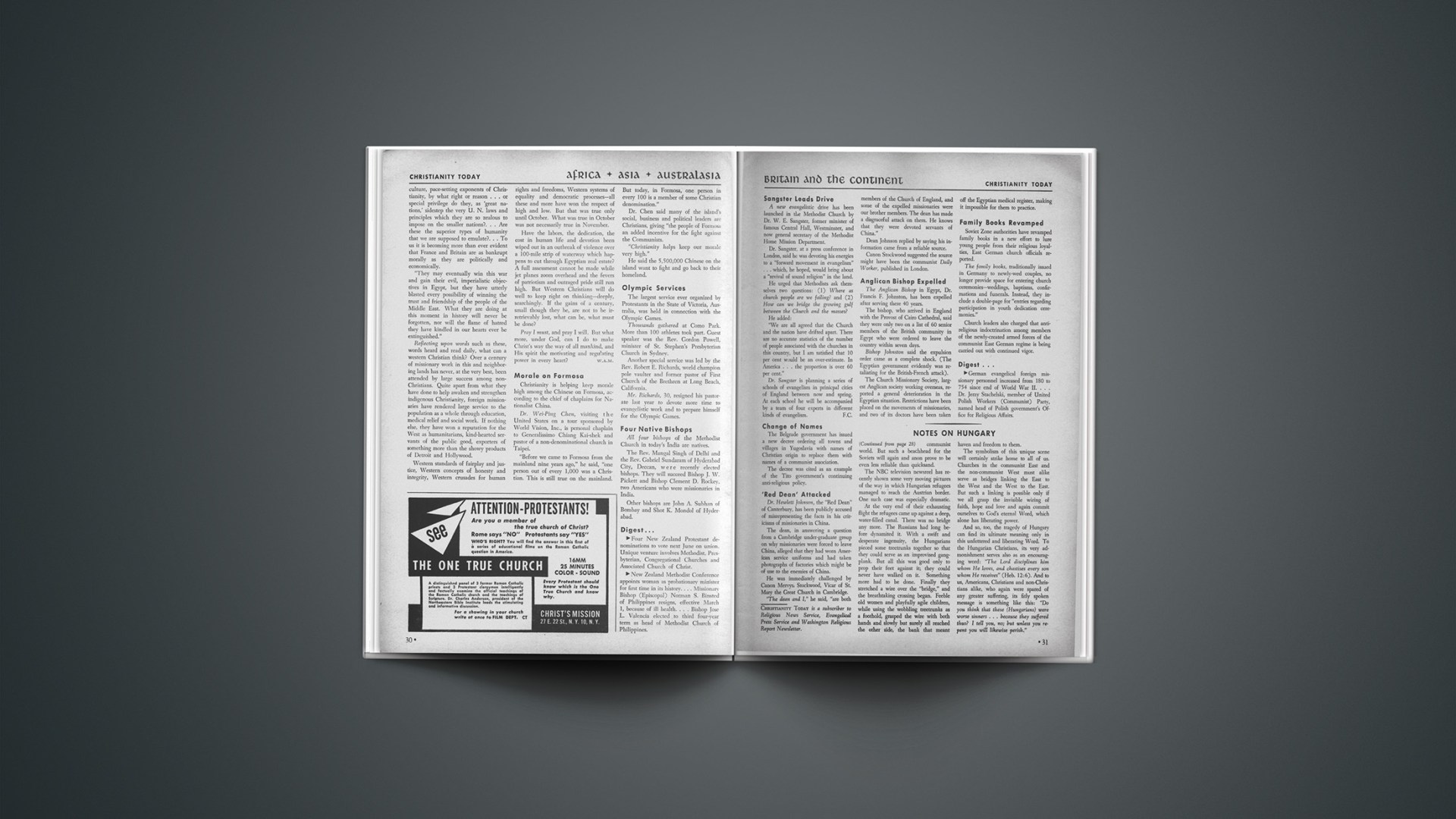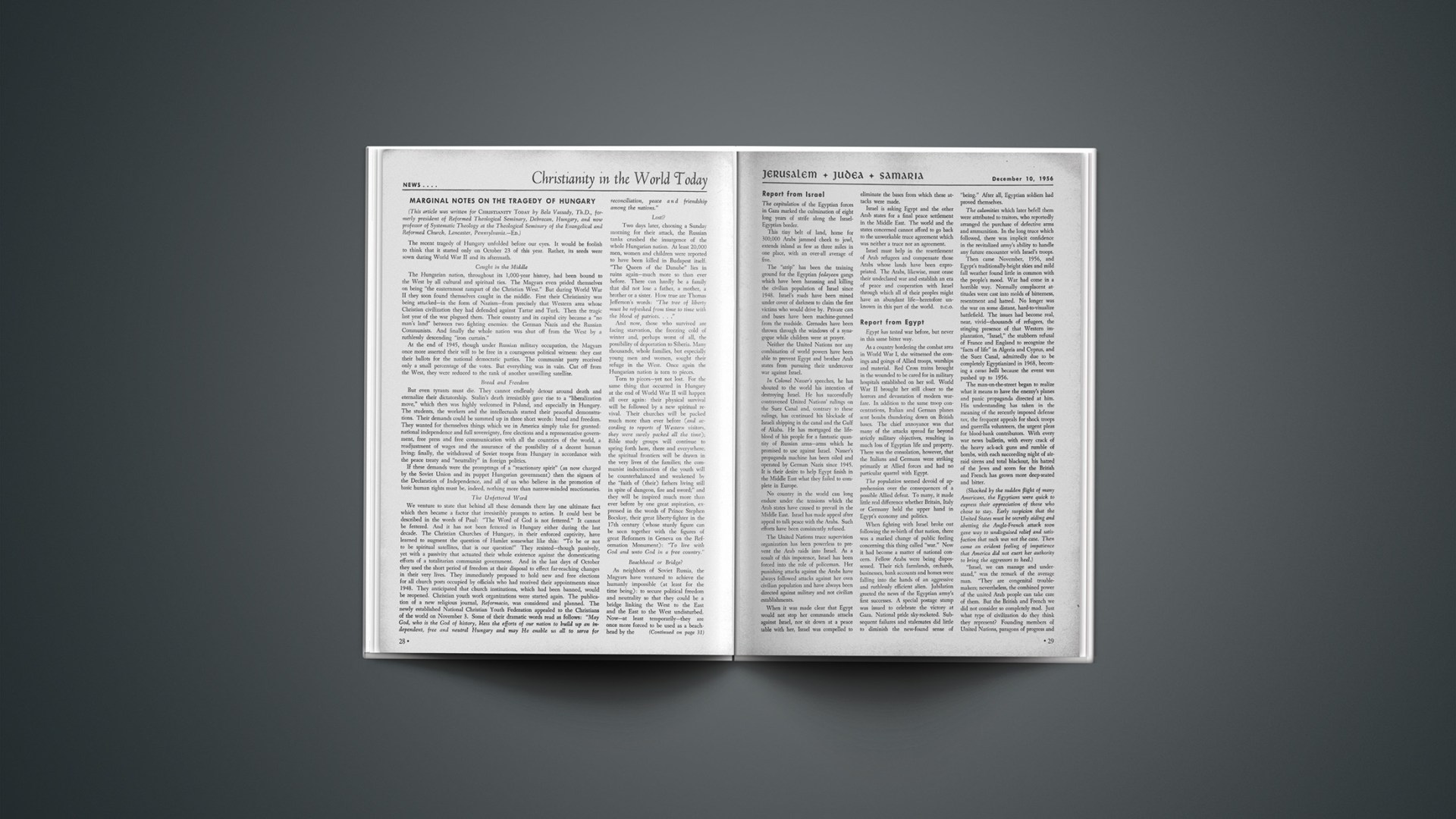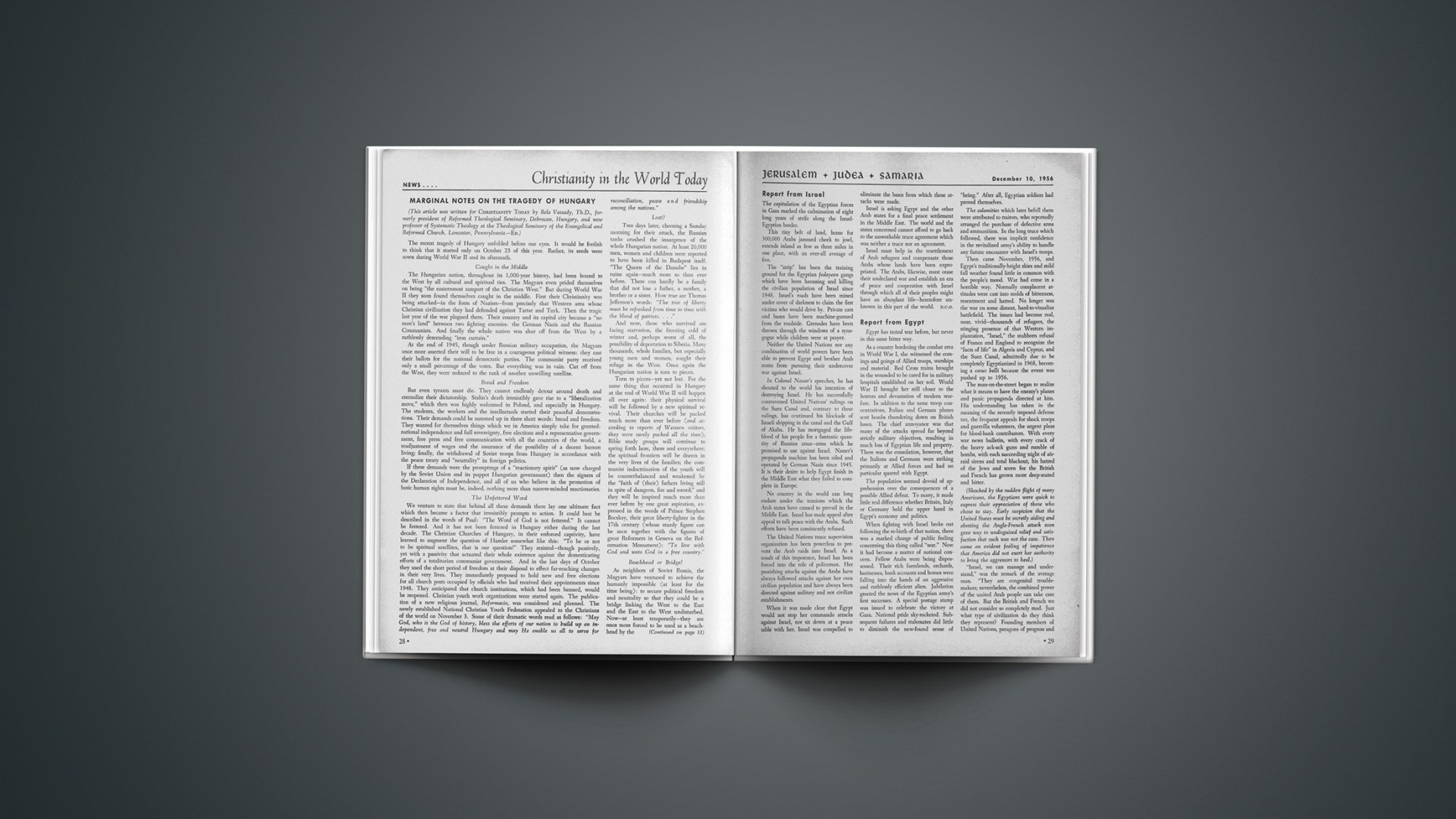The explosive situation in the Near East is a startling reminder that ever since World War I, the world has been confronted with an anomalous and even unprecedented state of affairs. It is the claim of a people to return and repossess a land that has not been theirs for nearly two thousand years. What other people in the world would venture to demand that the clock of history be put back two millenniums for their benefit? Yet within a decade the land of Palestine, which has been for centuries under non-Jewish control, with a population estimated in 1914 at less than 700,000, of which the majority were Arabs, has been partitioned in such a way that the state of Israel now has a population of 1,716,000, of whom nearly 90 per cent are Jews. Yet nearly a million Arabs are refugees outside of Israel and dependent upon a dole from the United Nations for their very existence.
A Religious Question
This is an amazing situation. To what is it due? It is due partly to Zionist agitation in England and America, partly to the widespread sympathy for the Jews because of the inhuman treatment they received in Europe during World War II. Consequently, the claim of the Zionists that Palestine belongs to them as the descendants of Abraham was accepted by many who would have emphatically rejected a similar claim by any other people to possess a land in which they had been for centuries an almost negligible minority. In fact, to evaluate the situation properly, we must view it not as a political question but as a religious one and ask ourselves, Do the promises of the Old Testament to which the Zionists appeal support their claim to the possession of the land; and does the New Testament which the Zionists reject confirm them in it? A number of considerations are involved in the answering of these important questions.
The promise to which the Zionists appeal is clearly-stated in Genesis 18:18, “Unto thy seed have I given this land, from the river of Egypt unto the great river, the river Euphrates”; and it is referred to repeatedly elsewhere. Does this settle the question? Does it give the Israeli a clear title to Palestine under the Abrahamic Covenant? We believe it does not and for the following reasons.
Conditioned On Obedience
This promise was conditioned on obedience to the will of God. Note the words, “because thou hast obeyed my voice” (Gen. 22:18) and also Genesis 26:5, where the renewal of the covenant with Isaac is explained by the words, “because that Abraham obeyed my voice, and kept my charge, my commandments, my statutes, and my laws.” This basic principle, that possession of the land and prosperity in it was conditioned on obedience, is stressed again and again. It is made especially clear in the solemn warnings in Leviticus 26 and Deuteronomy 28; and it is definitely declared that to be “scattered among the nations” will be the punishment of disobedience (cf. Deut. 4:27).
These prophecies plainly foretold the course of Israel’s history. When the people forsook the Lord in the days of the Judges, the Lord “sold” them into the hands of their neighbors, the Moabites, Ammonites, Midianites, and Philistines. Later He brought against them mighty enemies from distant lands to punish them. The situation in the days of Isaiah is graphically described in the “Great Arraignment” (chap. 1). Again, the Lord declared through his prophet that Assyria was “the rod” of his anger (Isa. 10:5). He used this rod to destroy the Northern Kingdom; and only a representative handful ever returned to the land. Many speak of the tribes of the Northern Kingdom today as “the lost tribes.” More than a century later Jeremiah (5:1) described the apostasy of Judah in words that remind us of Diogenes and his quest for an honest man; and Jeremiah declared to the Jewish “patriots” who were resisting Nebuchadnezzar that the king of Babylon was the Lord’s “servant” (25:9), that Jerusalem would certainly be taken by him, and that the Jews would go into captivity for seventy years. At the end of that time the Lord raised up Cyrus, whom He called “my shepherd” (Isa. 44:28); and Cyrus permitted the Jews to return to rebuild the temple. But it was only a believing remnant that returned; and they were subject to foreign rulers during most of the time that they were permitted to remain in the land of their fathers. Certainly the Old Testament teaches both prophetically and historically that possession of the land was conditioned on obedience to Him who had given it to Abraham his “friend” (Isa. 41:8).
Repentance A Prerequisite
Repentance was the condition of restoration to the land. This principle is stated with special clarity in Deuteronomy 30:1–10. The words “and shalt return unto the Lord thy God and obey his voice” precede and condition the promise “then the Lord will turn thy captivity.” This condition may properly be said to underlie all the promises of restoration that appear later in the prophecies of Isaiah, Jeremiah, Ezekiel, and others. And the course of history confirms it. It was when the people cried unto the Lord in the days of the Judges that He delivered them from their oppressors. Only a small remnant of the Ten Tribes (note Luke 2:36) returned with the believing Jews after the Babylonian captivity. A return in continued unbelief in Old Testament times would have been an act of defiance of their God who had driven them from the land because of their unbelief and disobedience to Him.
Dispersion A Punishment
The destruction of Jerusalem by Titus and the resultant dispersion of the Jews was the punishment for their sin of rejecting and slaying their long-promised Messiah. Toward the end of his earthly ministry and in anticipation of his death, Jesus clearly foretold to the Jews the consequences of their failure to accept Him. In the parable of the wicked husbandmen, He told them, “The kingdom shall be taken from you, and given to a nation bringing forth the fruits thereof” (Matt. 21:43). He foretold the utter destruction of the temple (Matt. 24:2) and declared that Jerusalem should be “trodden down of the Gentiles, until the times of the Gentiles are fulfilled” (Luke 21:24). All of these predictions have been fulfilled or are still being fulfilled. The Jews have been scattered for centuries, their land has been possessed by strangers, the site of their temple has been occupied for centuries by the Mosque of Omar.
Nationalism Rebuked
Jesus proclaimed a Gospel which was the fulfillment of the original promise to Abraham: “In thee shall all the families of the earth be blessed” (Gen. 12:3). Speaking to Nicodemus He promised everlasting life to “whosoever” believed in Him (John 3:16). To the Samaritan woman He declared that the time was then come when men need not go to Jerusalem or to Gerizim to worship God, that wherever men worship “in spirit and in truth” their worship is acceptable (John 4:23). At Nazareth He made such effective use of the Old Testament to rebuke the narrow nationalism of the Jews that they sought to slay Him (Luke 4:23–29). After His passion and before His ascension, He combined his announcement of universal sovereignty with the command, “Go ye therefore and teach all nations” (Matt. 28:18–19).
This world-embracing Gospel, an evangel that makes no distinction between Jew or Gentile, barbarian, Scythian, bond or free, was preached by the Apostles and especially by the Apostle Paul. The Christian Church was at first entirely Jewish. The great issue that came before it was not the admission of Jews but the admission of Gentiles into a church that was originally Jewish. It was the great privilege of Paul to proclaim the “mystery” of the complete equality of Jew and Gentile in the Christian Church (Eph. 3:1–13). It is quite true, and to the Church’s shame be it said, that for many centuries and even in our day she has failed to welcome the Jew into her communion. Instead she has hated him and “ghettoed” him. But despite her unfriendly attitude, many thousands of Jews have found their Messiah through the Church; and for all such the Jewish problem has been largely or wholly solved.
Land No Longer Important
Under the Christian dispensation the land, the city, and the temple have lost the importance that formerly attached to them. According to the Law of Moses it was almost a necessity for a believing Israelite to live in or near the land of Canaan. The tabernacle, and later the temple, was the center of worship for his people. He was required to go up to Jerusalem to celebrate the three annual feasts. For him Jerusalem and the temple had unique significance and importance. For the Christian, whether he be Gentile or Jew, all this is changed. A believing Jew is today as near heaven in the United States, where 5,000,000 of his fellow Israelites now live and apparently expect to continue to live, as if he were in Jerusalem. An unbelieving Jew is just as far from Heaven in Jerusalem as he would be in New York or London. For the Christian, whether Jew or Gentile, the land of Palestine has a sentimental interest. But that is all. It is only the Jew who still lives more or less in the Old Testament dispensation who regards the possession of the land as important. And part of its importance to him is due to racial pride and nationalistic aspirations. There are many open spaces in the world, many friendly nations, in which oppressed Israelites can find a refuge and a home without imperiling the peace of the world.
An Unjust Restoration
The attempt to restore the Jews to Palestine has proved to be unjust in itself and highly dangerous to the peace of the world. The Balfour Proclamation of 1917 was a war measure. Even before Allenby had captured Jerusalem, it promised the Jews a home in Palestine. Since then the British under their mandate and the United Nations under the leadership of Great Britain and of the United States (which has in the four great cities of New York, Chicago, Philadelphia, and Boston nearly a third of the entire Jewish population of the world) have allowed unlimited immigration, have partitioned Palestine between Jews and Arabs, and have allowed the Jews to extend their borders beyond the boundaries established by the UN General Assembly. Furthermore, they have taken no adequate steps to right the wrongs of the dispossessed Arabs, whose tragic condition fosters resentment and hate throughout the entire Moslem world. Palestine did not belong to the British. It did not and does not belong to the United Nations. The persecution of the Jews in Europe was a grievous act of injustice. But allowing the Jews to take possession of a large part of Palestine and to force hundreds of thousands of Arabs out of it is an equally grievous wrong. Two wrongs do not make a right. Israel’s demand that her occupation of a part of Palestine be accepted as a fait accompli and her obvious intention to bring in many more Jews and to increase her holdings in the land as need requires and opportunity offers naturally incense the Arabs. How could it be otherwise?
Ought Israel To Succeed?
It is not the purpose of this article to propose a solution of the snarl that has been allowed to develop in the Near East. But mention of a historical parallel may be instructive. More than eight hundred years ago, under the blessing of popes and priests, kings and knights and multitudes of misguided men—even women and children—sought for two centuries to “rescue” the holy places in Palestine from the hands of the infidels. “They made religion subservient to war and war subservient to religion.” The attempt failed. The Children’s Crusade was one of the greatest tragedies of history. Palestine remained until forty years ago a part of the Moslem world. We ask ourselves, ought the Crusades to have succeeded? The verdict of history seems to be, No! The fleshly sword of medieval chivalry was defeated by the scimitar of the followers of the False Prophet. We ask the same question about the present struggle over Palestine. Does the Israeli cause deserve to succeed? Should Christians be willing to plunge the nations into a third world conflict just to restore unbelieving Jews to, and to maintain them in, a land from which they were driven nearly two thousand years ago? We believe the verdict of history will be, No! May God grant that this verdict not be written in rivers of blood!
The Rev. Oswald T. Allis, Ph.D., D.D., was formerly professor of Old Testament at Princeton Theological Seminary and Westminster Theological Seminary. He is author of The Five Books of Moses, Prophecy and the Church, The Unity of Isaiah, and other volumes, and is a consulting editor of the Evangelical Quarterly.
See also the article that ran next to this one: “Israel in Her Promised Land.”

